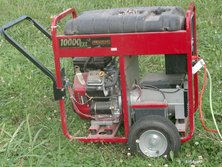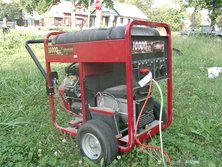Electrical generator
|
|
- "Generator" redirects here. For other uses, see generator (disambiguation)
Prokudin-Gorskii-30.jpg
An electrical generator is a device that produces electrical energy from a mechanical energy source. The process is known as electricity generation.
| Contents |
Developments
Before the connection between magnetism and electricity was discovered, generators used electrostatic principles. The Wimshurst machine used electrostatic induction or "influence". The Van de Graaff generator uses either of two mechanisms:
- Charge transferred from a high-voltage electrode
- Charge created by the triboelectric effect using the separation of two insulators (the belt leaving the lower pulley)
Electrostatic generators are inefficient and are useful only for scientific experiments requiring high voltages.
Faraday
In 1831-1832 Michael Faraday discovered that a potential difference is generated between the ends of an electrical conductor that moves perpendicular to a magnetic field. He built the first electromagnetic generator based on this effect, using a copper disc rotating between the poles of a horseshoe magnet. It produced a small direct current.
Dynamo
The dynamo was the first electrical generator capable of delivering power for industry, and is still the most important generator in use in the 21st century. The dynamo uses electromagnetic principles to convert mechanical rotation into an alternating electric current.
The first dynamo based on Faraday's principles was built in 1832 by Hippolyte Pixii, a French instrument maker. It used a permanent magnet which was rotated by a crank. The spinning magnet was positioned so that its north and south poles passed by a piece of iron wrapped with wire. Pixii found that the spinning magnet produced a pulse of current in the wire each time a pole passed the coil. Furthermore, the north and south poles of the magnet induced currents in opposite directions. By adding a commutator, Pixii was able to convert the alternating current to direct current.
Gramme dynamo
However, both of these designs suffered from a similar problem: they induced "spikes" of current followed by none at all. Antonio Pacinotti, an Italian scientist, fixed this by replacing the spinning coil with a toroidal one, which he created by wrapping an iron ring. This meant that some part of the coil was continually passing by the magnets, smoothing out the current. Zénobe Gramme reinvented this design a few years later when designing the first commercial power plants, in Paris in the 1870s. His design is now known as the Gramme dynamo. Various versions and improvements have been made since then, but the basic concept of a spinning endless loop of wire remains at the heart of all modern dynamos.
Concepts
It is important to understand that the generator creates an electric current, but does not create electric charge, which is already present in the conductive wire of its windings. It is somewhat analogous to a water pump, which creates a flow of water but does not create the water itself.
Other types of electrical generator exist, based on other electrical phenomena such as piezoelectricity, and magnetohydrodynamics. The construction of a dynamo is similar to that of an electric motor, and all common types of dynamos could work as motors. Also, all common types of electric motors could work as generators.
The Generator rotor is turned by a device termed a Prime mover, often a Diesel engine, Steam turbine, Water turbine or Gas turbine coupled to the rotor shaft.
Equivalent circuit
Generator-model.png
G = generator
VG=generator open-circuit voltage
RG=generator internal resistance
VL=generator on-load voltage
RL=load resistance
The equivalent circuit of a generator and load is shown in the diagram on the right. To determine the generator's <math>V_G<math> and <math>R_G<math> parameters, follow this procedure: -
- Before starting the generator, measure the resistance across its terminals using an ohmmeter. This is its DC internal resistance <math>R_{GDC}<math>.
- Start the generator. Before connecting the load <math>R_L<math>, measure the voltage across the generator's terminals. This is the open-circuit voltage <math>V_G<math>.
- Connect the load as shown in the diagram, and measure the voltage across it with the generator running. This is the on-load voltage <math>V_L<math>.
- Measure the load resistance <math>R_L<math>, if you don't already know it.
- Calculate the generator's AC internal resistance <math>R_{GAC}<math> from the following formula:
- <math>R_{GAC} = {R_L} \left( {{{V_G}\over{V_L}}-1} \right)<math>
Note 1: The AC internal resistance of the generator when running is generally slightly higher than its DC resistance when idle. The above procedure allows you to measure both values. For rough calculations, you can omit the measurement of <math>R_{GAC}<math> and assume that <math>R_{GAC}<math> and <math>R_{GDC}<math> are equal.
Note 2: If the generator is an AC type (not a dynamo), use an AC voltmeter for the voltage measurements.
Larger Examples
Much larger examples exist from the one already pictured, indeed the set below is nothing compared to some containerised sets.
This set is an 100kVA set which produces 415V at around 100A a phase. It's powered by an 6.7 Litre Turbo Charged Perkins Phaser 1000 Series engine, and consumes approximately 27 Litres of fuel an hour, on an 400 Litre tank. These diesel engines are run in the UK on Red_diesel and rotate at 1500RPM. This produces power at 50Hz, which is what is used in the UK. Other countries, and aviation generators rotate at 1600RPM and produce power at 60Hz.
Big_boy.JPG
Control_panel.jpeg
Filterside.jpeg
Fuel_filters.jpeg
Governor.jpeg
Turbo_starter.jpeg
Patents
- Template:US patent -- Magneto-Electric Machines : Thomas Edison's main continous current dynamo. The device's nickname was the "long-legged Mary-Ann". This device has large bipolar magnets. It is inefficient.
- Template:US patent -- Dynamo-Electric Machine : Edison's improved dynamo which includes an extra coil and ultilizes a field of force.
- Template:US patent -- Dynamo Electric Machine - Nikola Tesla's construction of the alternating current induction motor / generator.
- Template:US patent -- Dynamo Electric Machine - Tesla's "Unipolar" machine (i.e., a disk or cylindrical conductor is mounted in between magnetic poles adapted to produce a uniform magnetic field).
- Template:US patent -- Armature for Electric Machines -Tesla's construction principles of the armature for electrical generators and motors. (Related to patents numbers US327797, US292077, and GB9013.)
- Template:US patent -- Method of Operating Arc-Lamps - Tesla's alternating current generator of high frequency alternations (or pulsations) above the auditory level.
- Template:US patent -- Alternating Electric Current Generator - Tesla's generator that produces alterations of 15000 per second or more.
See also
de:Elektrischer Generator es:Generador fr:Générateur électrique id:Generator listrik it:Dinamo he:גנרטור חשמלי nl:Dynamo ja:発電機 pl:Prądnica ru:Электрический генератор fi:Generaattori zh:发电机


